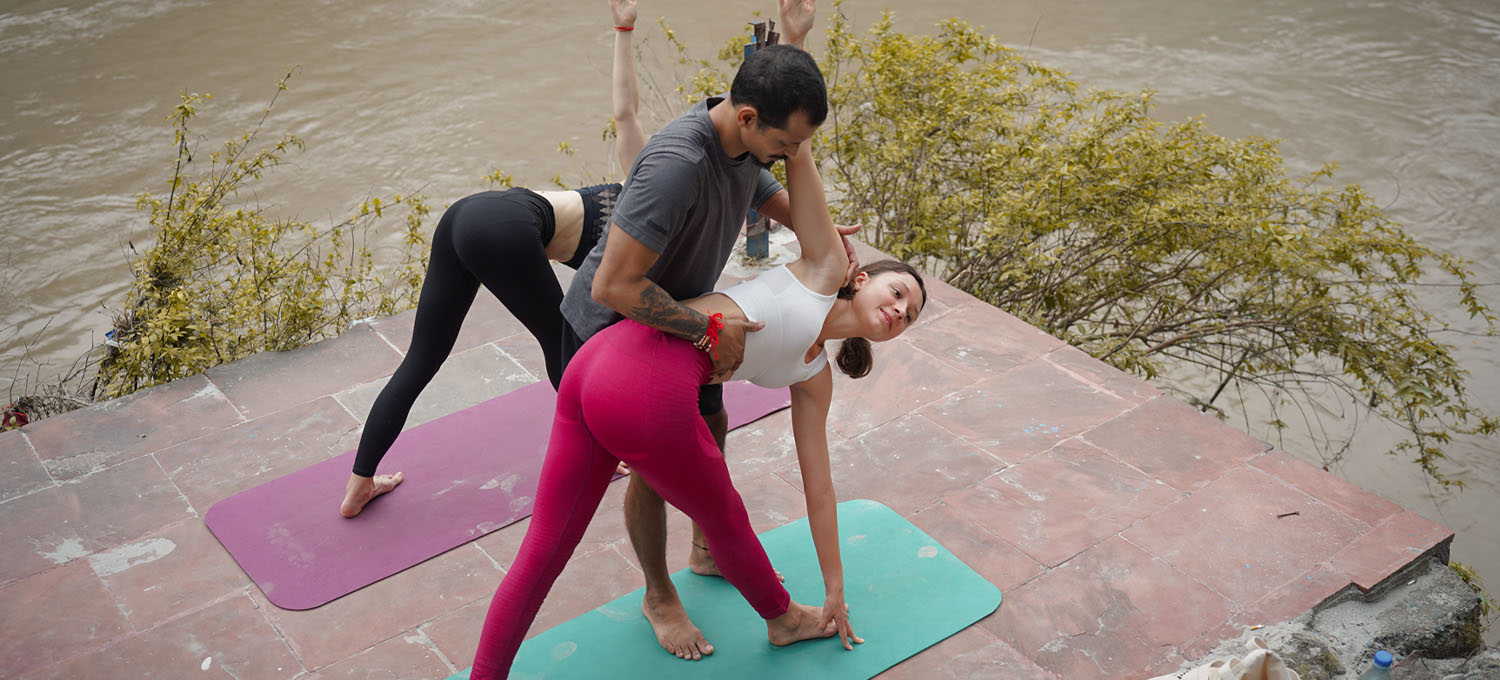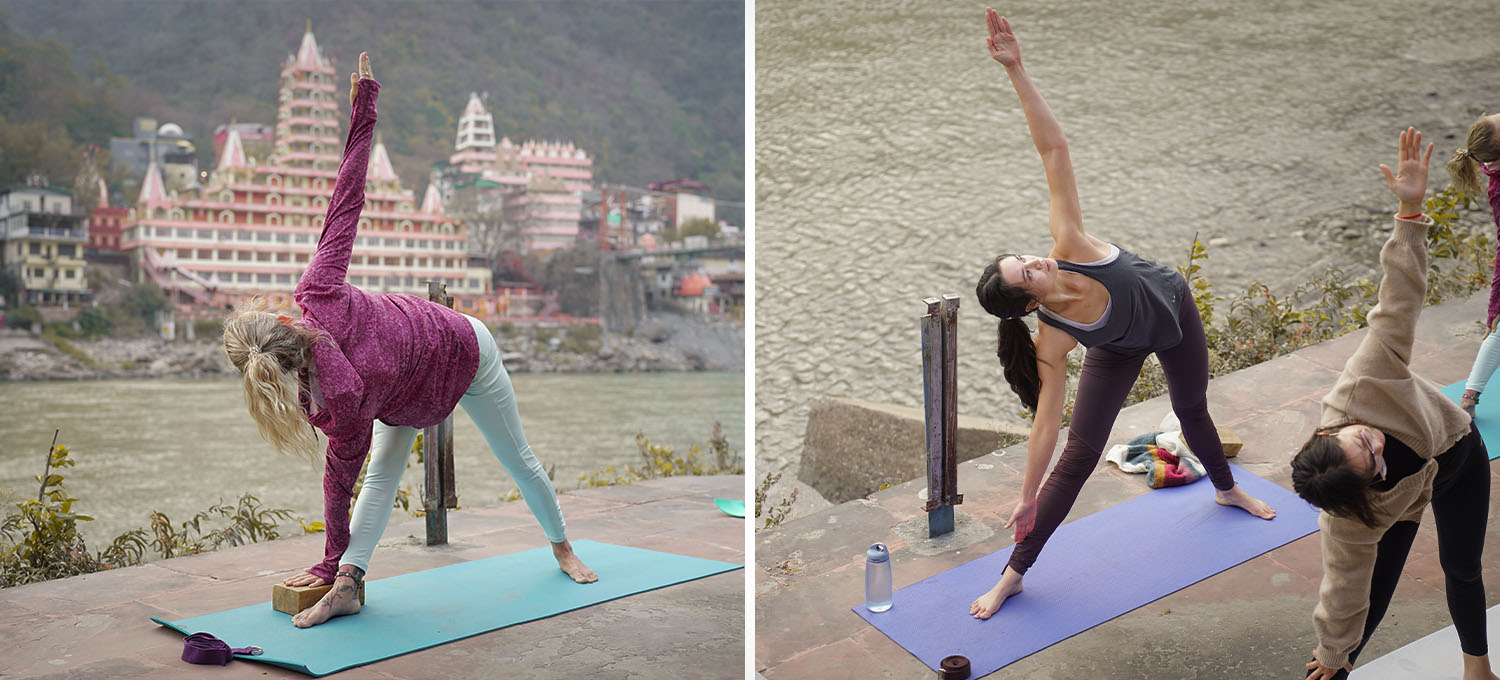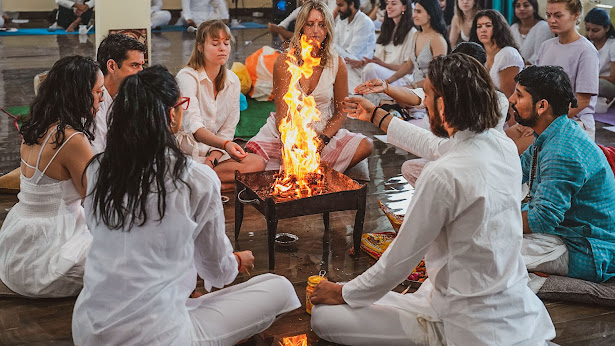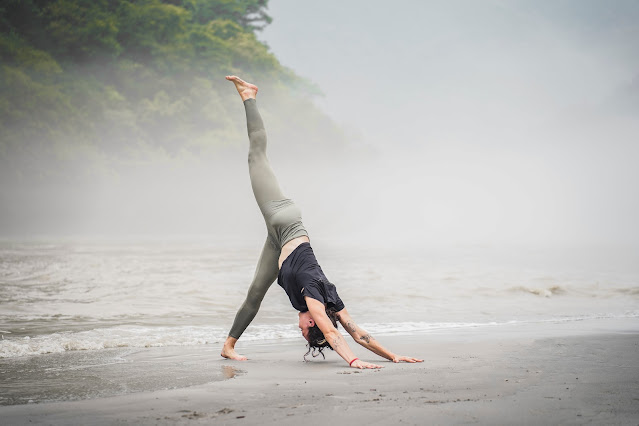How to Do Trikonasana with Benefits and Alignment Tip
A COMPLETE GUIDE TO TRIANGLE POSE (TRIKONASANA): BENEFITS, STEP-BY-STEP GUIDE, AND PRECAUTIONS
One of the fundamental standing postures in yoga is Trikonasana, which is also known as Triangle Pose. The word "Trikonasana" is derived from the Sanskrit words "trikona" meaning triangle and "asana" meaning pose.
The posture is known as the Trikonasana as while performing this, the body looks like a triangle, with one leg extended out to the side and the other foot firmly grounded. The torso is then tilted sideways, allowing one hand to reach the floor or a block while the other arm extends upward, forming a straight line.
Trikonasana and Its Significance in Modern Lifestyle
Trikonasana is greatly necessary for modern lifestyles due to its numerous benefits that address common issues faced in today's sedentary and stressful routines. The asana also resolves the issue that occurs by sitting for longer periods, such as tight hips and lower back pain, by stretching and strengthening the muscles in those areas.
It also promotes better posture, which is often compromised by desk jobs and excessive screen time. Trikonasana improves balance and stability, reducing the risk of falls and injuries. Additionally, it enhances digestion and relieves digestive discomfort caused by unhealthy eating habits.
The calming and grounding nature of Trikonasana also aids in reducing stress and anxiety, providing a much-needed mental and emotional respite from the fast-paced modern world.
Trikonasana - A Fundamental Yoga Pose
Trikonasana, or Triangle Pose, holds a significant place as a fundamental yoga pose due to several key reasons.
Firstly, Trikonasana embodies the essence of yoga as it combines strength, flexibility, and balance. The pose engages the legs, core, and back muscles, building strength and stability throughout the body. At the same time, it stretches the hamstrings, hips, and side body, promoting flexibility and releasing tension.
Secondly, Trikonasana serves as a foundational pose that forms the basis for more advanced postures. It establishes proper alignment, body awareness, and proprioception. Practicing Trikonasana helps individuals develop a solid foundation for their yoga practice, allowing them to progress safely and effectively.
Furthermore, Trikonasana offers a range of physical and mental benefits suitable for modern lifestyles. It improves posture, counteracting the negative effects of sedentary activities. The pose enhances digestion, alleviates back pain, and releases tension in the neck and shoulders, which are common issues faced in today's society.
Additionally, Trikonasana cultivates mindfulness and concentration by requiring focus and balance. It encourages a sense of grounding, promoting a connection between mind, body, and breath.
Overall, Trikonasana's multifaceted nature, its ability to lay the groundwork for advanced postures, and its practical benefits make it an essential and fundamental yoga pose for practitioners of all levels.
yoga teacher training in rishikesh | 200 hour yoga teacher training in rishikesh | 500 hour yoga teacher training in rishikesh

Step-by-Step Guide to Trikonasana (Triangle Pose)
- Begin by standing at the top of your mat in Tadasana. Stand tall with your feet hip-width apart, arms by the side of the body, and your body aligned.
- Inhale and raise your right hand above your head straight. Make sure that the right arm is in parallel with the right ear.
- Exhale slowly and bend your torso to the left side of the waist.
- At the same time, make your left arm touch the ankle of the left leg.
- As you tilted left, your right arm should be horizontal to your head.
- Hold in this position for a while with your elbows and knees straight.
- Hold it for at least 30 seconds.
- Inhale and stand erect.
- Repeat the same for the opposite side.
Benefits of Trikonasana
Strengthening the legs: In Trikonasana, the legs are actively engaged to maintain balance and stability. When you do the asana, the front leg builds strength in the quadriceps and the hamstrings. The back leg also gets engaged, helping to strengthen the calves and thighs.
Stretching the hamstrings: As you extend your torso forward and reach your hand towards the front foot, the back of the front leg experiences a deep stretch. This stretch targets the hamstrings, which can often be tight due to prolonged sitting or lack of flexibility. Regular practice of Trikonasana can help increase hamstring flexibility and reduce the risk of injuries.
Opening the hips: Trikonasana involves a wide stance, which helps in opening and stretching the hips. The hip abductor muscles, such as the gluteus medius and minimus, are engaged during this pose, promoting greater mobility and flexibility in the hip joints.
Strengthening the groin: The action of pressing the feet into the ground and activating the leg muscles in Trikonasana also engages the adductor muscles of the inner thighs.
Improving overall balance and stability: As a standing pose, Trikonasana requires a good sense of balance and stability. Regular practice of this posture can help strengthen the muscles responsible for maintaining balance, including the leg muscles, core muscles, and the muscles around the ankles.
Stimulating digestion and metabolism: The twisting action involved in Trikonasana can help stimulate the abdominal organs, including the digestive system. This can aid in improving digestion and promoting a healthy metabolism.
Chest expansion: As you extend one arm upwards and the other arm reaches towards the front foot in Trikonasana, the chest is encouraged to open up and expand. This movement stretches the pectoral muscles (chest muscles) and the intercostal muscles (muscles between the ribs), helping to counteract the forward rounding of the shoulders that often occurs due to poor posture or excessive sitting.
Shoulder stretching: In Trikonasana, the extended arm reaches overhead, creating a lengthening and stretching sensation in the shoulder muscles, including the deltoids and the rotator cuff muscles. Regular practice of this pose can help release tension and tightness in the shoulders, promoting better shoulder mobility and reducing the risk of shoulder-related discomfort.
Improved posture: Poor postures, such as rounded shoulders and a hunched back, can contribute to various issues like neck and back pain. Trikonasana helps in strengthening and stretching the muscles involved in maintaining good posture, including the back muscles, core muscles, and shoulder girdle muscles. By regularly practicing this pose, you can develop a greater awareness of your posture and strengthen the muscles necessary to support an upright alignment.
Spinal extension: Trikonasana involves a lateral flexion of the spine, which helps in lengthening and stretching the muscles on the sides of the torso. This action encourages proper alignment and extension of the spine, promoting a more upright posture.
Opening the shoulder blades: The action of reaching the extended arm overhead and the other arm towards the front foot in Trikonasana can also help in opening and spreading the shoulder blades. This movement helps to counteract the tendency of the shoulder blades to pinch together and promotes a more open and expanded chest.
Mindfulness and Presence: Trikonasana requires concentration and mindful awareness of the body's alignment, balance, and breath. By bringing attention to the present moment and the sensations within the body, the practice of Trikonasana helps to cultivate mindfulness and presence. This focus on the present moment can promote a sense of calmness and clarity in the mind.
Breath Awareness: Throughout the practice of Trikonasana, paying attention to the breath is essential. Deep, steady breaths help to calm the nervous system and bring a sense of relaxation to the body and mind. By consciously observing the breath during the pose, you can enhance your awareness of the present moment and establish a connection between the breath and the movements of the body.
Mental Concentration: Holding and maintaining the alignment of the body in Trikonasana requires mental concentration. This focus on the physical sensations, the breath, and the alignment helps to quiet the mind and enhance concentration. By consistently practicing Trikonasana, you can improve your ability to sustain focus and concentration not only on the mat but also in your daily life.
Stress Reduction: Trikonasana, like other yoga postures, has a calming effect on the nervous system. The physical stretch and opening of the body, combined with the mindful approach to the practice, can help to reduce stress and anxiety. The relaxation response induced by Trikonasana can promote a sense of calmness and well-being.

Warm-up Exercises to Prepare the Body for Trikonasana
- Neck Rolls Begin by gently rolling your neck in clockwise and counterclockwise circles. This helps release tension in the neck and upper back, promoting mobility and relaxation.
- Shoulder Rolls The exercise warms up the shoulder joints and releases tension in the upper body making it ready to perform Trikonasana.
- Cat-Cow Stretch Repeating this fluid movement several times helps to warm up the spine and stretch the back muscles. Furthermore, it makes you ready for Triangle Pose.
- Side Stretches Side stretches prepare the side body for the lateral stretch in Trikonasana.
- Standing Forward Bend Stand with your feet hip-width apart and slowly fold forward from the hips, allowing your upper body to hang relaxed. Bend your knees slightly if needed. This stretches the hamstrings and calves, which are engaged in Trikonasana.
- Low Lunge Step one foot forward into a lunge position, with the front knee bent and the back knee lowered to the ground. Place your hands on your front thigh for support. This stretches the hip flexors and prepares the legs for the wide stance in Trikonasana. Repeat on the other side.
Precautions and Contradictions of Trikonasana for Individuals with Specific Conditions or Injuries
While Trikonasana (Triangle Pose) can be beneficial for many individuals, it's important to exercise caution and consider contraindications if you have specific conditions or injuries. Here are some precautions and contraindications to be aware of:
- High or low blood pressure: Individuals with high blood pressure generally need to avoid practices like Trikonasana, as they can temporarily increase blood pressure. Similarly, individuals with low blood pressure might feel tiredness or dizziness during the practice.
- Neck or spinal injuries: Individuals with neck or spinal injuries should approach Trikonasana with caution. Avoid excessive twisting or straining of the neck during the pose.
- Diarrhea or recent abdominal surgery: Trikonasana involves gentle pressure on the abdomen, which may not be suitable for individuals with diarrhea or those who have recently undergone abdominal surgery. It's best to avoid the pose in such cases.
- Herniated disc or sciatica: If you have a herniated disc or sciatica, extreme caution is advised when performing Trikonasana. Twisting movements in the spine can potentially aggravate these conditions. It's recommended to work with a knowledgeable yoga instructor or healthcare professional to modify the pose or explore alternative postures.
- Hip, knee, or ankle injuries: Individuals with hip, knee, or ankle injuries should exercise caution and modify Trikonasana as needed. Avoid deep stretches or excessive strain on the affected joint.
- Pregnancy: Pregnant individuals should approach Trikonasana with caution, especially during the second and third trimesters. Modifications may be necessary to accommodate the growing belly and to ensure comfort and safety. It's recommended to consult with a prenatal yoga instructor or healthcare professional for guidance on modified versions of Trikonasana during pregnancy.
Incorporating Trikonasana into a Yoga Sequence
Integrating Trikonasana (Triangle Pose) into a yoga sequence or routine can enhance its benefits and create a well-rounded practice. Here's some guidance on incorporating Trikonasana into a yoga sequence:
1. Start with a Warm-up:
Begin your practice with a gentle warm-up sequence to prepare the body for Trikonasana. This can include movements like neck rolls, shoulder rolls, cat-cow stretches, and standing forward bends. Focus on stretching and mobilizing the areas involved in Trikonasana, such as the neck, shoulders, spine, hamstrings, and hips.
2. Standing Poses:
Trikonasana is a standing pose, so it can be beneficial to incorporate other standing poses into your sequence. Poses like Warrior I, Warrior II, and Extended Side Angle Pose can complement Trikonasana and further engage the legs, hips, and core muscles.
3. Sun Salutations:
Including a few rounds of Sun Salutations in your sequence can help build heat, increase flexibility, and prepare the body for Trikonasana. Move through variations of Sun Salutations, such as Sun Salutation A or Sun Salutation B, incorporating lunges and forward folds to warm up the entire body.
4. Balancing Poses:
Adding balancing poses like Tree Pose or Half Moon Pose after Trikonasana can further challenge your balance and stability, while also engaging the core muscles and improving focus and concentration.
5. Seated Poses:
After the standing poses, transition into seated poses to provide a gentle release and stretch for the body. Poses like Seated Forward Fold, Bound Angle Pose, and Wide-Legged Forward Bend can help lengthen the hamstrings and open the hips.
6. Supine Twists and Savasana:
Conclude your sequence with supine twists, such as Reclining Spinal Twist, to release any remaining tension in the spine. Finally, allow yourself a few minutes in Savasana (Corpse Pose) to relax and integrate the benefits of your practice.
Energetic and Symbolic Aspects of Trikonasana
In yoga philosophy, Trikonasana (Triangle Pose) holds energetic and symbolic aspects that can be explored. Here are some insights into the energetic and symbolic dimensions of Trikonasana:
- Stability and grounding: Trikonasana is associated with the root chakra (Muladhara), which represents stability, grounding, and a sense of rootedness. The wide stance and firm foundation in Trikonasana symbolize a connection to the earth, fostering a sense of stability and grounding both physically and energetically.
- Balance of opposites: Trikonasana embodies the balance of opposites. The pose creates a dynamic equilibrium between expansion and grounding, lengthening and stability, and strength and flexibility. This balance reflects the principle of finding harmony within the opposing forces present in life and within oneself.
- Energy flow and expansion: Trikonasana is believed to facilitate the flow of energy throughout the body. The extended arms and legs create a triangular shape, representing the expansion and circulation of prana (life force energy). The lateral stretch in Trikonasana is thought to open energy channels along the sides of the body, promoting a sense of expansion and vitality.
- Awakening the Manipura chakra: Trikonasana can also be associated with the activation of the Manipura chakra, located at the solar plexus. The engagement of the core muscles in Trikonasana helps stimulate this energy center, promoting a sense of empowerment and inner strength.
- Opening and liberation: Trikonasana involves a deep lateral stretch, creating space and opening along the side body. This expansion can be symbolic of releasing tension, restrictions, and emotional blockages. It encourages a sense of liberation and freedom, both physically and metaphorically.
- Integration of body, mind, and spirit: As a holistic practice, Trikonasana embodies the integration of body, mind, and spirit. The alignment and conscious engagement of the body in the pose require mental focus and concentration, fostering a connection between the physical body and the mind. This integration cultivates a sense of presence and can support the exploration of deeper levels of self-awareness.
Trikonasana, in short, is a versatile yoga posture that can be modified and adapted to suit different levels of flexibility and experience. It is often incorporated into yoga sequences or practiced as a standalone pose to promote strength, flexibility, and balance in the body while fostering a sense of calm and focus in the mind.




Comments
Post a Comment